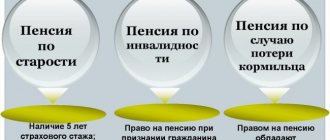The principle of pension formation
In 2002, a large-scale reform was carried out in the Russian Federation, which determined the transition of the pension system to insurance principles. In accordance with the law, every citizen is required to be registered in the compulsory pension insurance system.
When carrying out labor activities for him, funds in the amount of 22% of his salary are contributed to the Pension Fund of Russia for the purposes provided for by the compulsory pension fund.
These are the so-called insurance premiums. The responsibility for contributing them to the Pension Fund rests with the employer. Important! If a citizen conducts business activities or provides services under civil contracts as an individual, then the obligation to pay insurance premiums rests with him personally.
Their amount is calculated according to special rules. Funds transferred as contributions are converted into pension points, which make up the individual pension coefficient (IPC). It is this parameter that characterizes the volume of a citizen’s pension rights.
However, in addition to the insurance pension, there is also a funded pension. It is formed from the same contributions. At the same time, funds in the amount of 6% are allocated to the funded part of the pension, while 16% goes to the insurance part. In general, citizens, with a few exceptions, choose for themselves whether to form the funded part of their pension payments or not.
Since 2014, the Government of the Russian Federation has introduced a moratorium on contributions to the funded part. In other words, all contributions are directed only to the formation of an insurance pension. Today it is known that the moratorium will last until 2021 inclusive.
For the purposes provided for by the compulsory pension system, citizens have the right to independently determine where they will form their funded pension - in the state pension fund (PFR) or in a non-state pension fund (NPF).
What is OPS
OPS stands for compulsory pension insurance. This is a government program that has been in effect since the introduction of pension reform in 2002 for citizens born in 1967 and younger. Employers made insurance contributions for each employee, consisting of two parts. The first part - since 2010, amounting to 16% of the wage fund - was sent to the budget of the Pension Fund of Russia (PFR) for the payment of current pensions. At the expense of the second, which amounted to 6% of the wage fund, individual pension savings of Russian citizens were formed.
But now deductions to savings accounts are no longer made. In 2013, the government decided to introduce a moratorium on the transfer of insurance contributions to the funded part of the pension. This is often called “freezing” savings. As a result, since 2014, mandatory employer contributions do not replenish the funded pension, but go into the “common pot” of the Pension Fund (in the amount of 22% of the wage fund) to pay insurance pensions to today’s pensioners. However, the employer’s contributions to the Pension Fund are not wasted; they are credited to the citizen’s individual pension account in the form of points. You can read in detail about how this happens in our article on pension points.
What are pension points and how does it work?
The old-age labor pension in Russia consists of several parts. The first and main part of it is insurance. It is paid by the Pension Fund of Russia and is calculated using the individual pension coefficient - that is, the sum of pension points.
What is an NGO
NPO stands for non-state pension provision. This is an opportunity to organize a second, additional pension for yourself by concluding an agreement with a non-state pension fund (NPF) and making contributions yourself. Pension reserves are formed from voluntary contributions of citizens to non-state pension funds.
Many pension funds, including NPF SAFMAR, simultaneously engage in both OPS and NPO. You can store state pension savings and create additional ones either in one fund or in different ones. But it is worth understanding that NGOs have a number of differences from OPS.
What are the differences between these systems?
The main difference is that the activities of OPS funds are strictly regulated by the Central Bank, while NGOs are a little more free from restrictions.
Let's start with the fact that the size of the state pension now largely depends on the official length of service and decisions of the government, and payments under NPO are more likely to depend on the size and frequency of independent contributions of the citizen, as well as on the composition of the investment portfolio and market conditions.
When drawing up an NPO agreement, you can choose the conditions that are convenient for yourself: independently determine the comfortable amount and frequency of contributions, the type of pension payment, the rules for transferring pension savings to another fund and the procedure for transferring savings by inheritance. For OPS, all these rules are predetermined by the state, and the fund’s client cannot influence them in any way.
Due to the freezing of funded pensions, funds for compulsory pension insurance will now grow only at the expense of investment income. And you can add as much money to NGOs as you like and, in addition, receive a tax deduction.
Investment strategies for OPS and NPO are also usually different, because the Central Bank has set different restrictions on the investment portfolio. Profitability, accordingly, also varies.
The funds are required to invest at least 90% of pension savings in financial instruments with minimal risk, the return of which is relatively low. And NPFs can offer a choice of both conservative and aggressive investment strategies - more risky, but in the long term bringing greater income.
The pension savings with which the client entered the fund are guaranteed by law. Let’s say that the insurer, based on investment results over the 5 years of the contract, reduced these savings or lost its license. In this case, during an urgent transition (after five years), according to the law, the funds will be replenished from pension reserves up to the guaranteed amount.
Voluntary contributions are not yet insured by the state (industry associations of non-state pension funds are currently conducting relevant negotiations with the Central Bank). If the fund fails, there is no guarantee that you will get your savings back.
But if you want to withdraw the money accumulated in NPO before retirement, there is such an opportunity, unlike OPS. The agreement with the NPF will necessarily indicate the procedure for calculating the redemption amount, that is, the money that will be returned to you if you want to terminate the agreement with the fund.
What is the difference between NPF and Pension Fund?
There are two types of pension funds in Russia – state and non-state. Their distinctive features are that the state pension fund is subordinate only to the state, and the non-state one is one of the private organizations. It should also be noted that the Pension Fund, unlike the Non-State Pension Fund, is part of the country’s budget system. No non-state fund can be included in it. These two differences are the main ones when distinguishing between these two structures and are decisive when choosing one or another fund.
But the differences don't end there. The second distinction is the goals and objectives set, as well as the path that needs to be taken to get there. NPFs and Pension Funds have a common task - to accumulate pension investments for their further increase and payments to citizens upon retirement. But non-governmental organizations can also engage in other tasks that are not faced by the state fund.
The third distinctive feature is the founders of organizations. The founder of the state pension fund is the State Management Company, and all investments are made exclusively thanks to it. The NPF, in turn, can interact with one management company or select several. This significantly reduces investment risks and allows you to choose a profitable strategy of action. Whoever will be the founder is to a greater extent the determining factor for citizens who decide to choose a non-state pension fund. After all, it is he who will formulate benefits for payments in the future. These factors determine the profitability of both funds, and in the long term it shows that it is higher in NPFs.
What is the difference between a state and a non-state fund?
The operating principles of both categories of pension funds are basically identical. In both cases, the policyholder transfers the established amount of contributions to replenish the personal account that each citizen has.
However, there are legislative and legal differences for both types of funds. The state structure is completely dependent on decisions made at the government level and is also fully controlled by federal authorities. At the same time, control over the work of non-state funds is carried out only partially.
At the same time, in some issues, NPFs have greater freedom in decision-making.
For insured persons, several criteria are important, making up a list that determines which is better - a state pension fund or a non-state one. Here are the differences that play a key role in choosing a pension fund:
- The stability of the institution itself;
- Reliability regarding pension payments;
- Opportunities for investing in income-generating instruments;
- Profitability of pension contributions and the amount of pension payments;
- And, of course, the fact that the fund has guarantees to its insured persons and policyholders is important.
At the same time, policyholders may be interested in some questions regarding what is better to prefer - a state or non-state pension insurance fund. The interest of policyholders lies primarily in the area of powers granted by different categories of funds. This is due to the fact that pension insurance funds, acting as insurers, have certain rights and even obligations with regard to conducting inspections of policyholders, the regularity and transparency of the receipt of insurance premiums, and the state of financial documentation for the payment of contributions. Such procedures do not bring great delight to employers, and therefore it would be more convenient for them to cooperate with the most loyal structures.
Where do PFR and NPF management companies invest money?
The funded pension of Russians can be kept both in the Pension Fund and in the Non-State Pension Fund. The main task of insurers is to preserve savings and ensure their profitability at a level not lower than inflation (at least). The main goal is to provide a serious increase in your future pension due to high income from investment. To do this, management companies of Pension Funds and Non-State Pension Funds invest savings in various financial instruments: bonds, government securities, deposits, and so on. Important: the funds themselves do not currently invest pension savings. This work is carried out by management companies under a contract with them. This is called "fiduciary management."
The “style” of investment is one of the main differences between a state pension fund and a private one. By default, the Pension Fund transfers funds to the management of the state management company (GMC) VEB.RF. State Management Company VEB.RF adheres to a conservative investment policy, investing only in deposits, bonds and government securities. The capabilities of non-state pension funds are generally wider: they have the right to invest up to 10% of funds in high-risk assets (for example, shares). Such investments promise big profits, but can also bring losses if, for example, stock prices go down. For the same reason, in profitability ratings, NPFs can occupy both first and last places in terms of profitability: much depends on whether the fund got it right with the choice of high-risk assets. And GUK VEB.RF, despite the conservative nature of investing, is, as a rule, among the “strong middle peasants”: the returns on its portfolios exceed inflation and the results of a number of non-state pension funds.
Which is better NPF or Pension Fund?
Due to the fact that citizens are given the right to choose where to place funds for a funded pension, many of them have questions about what to choose - the Pension Fund or the Non-State Pension Fund. In this case, placement in a particular organization has its pros and cons, which should be examined in more detail.
Pros and cons of the state pension fund
Considering the positive and negative aspects of the Pension Fund's activities, experts get off with a couple of sentences, talking about the advantages of the fund, and one about the disadvantages.
We quote them verbatim:
- The advantage of a state fund is its reliability - there is absolutely no risk of losing savings;
- regular indexation linked to inflation.
The disadvantages include the low profitability of funds stored in the Pension Fund.
If we talk about the advantages, they are stated precisely and even with a strong desire you will not find more. But you need to deal with the disadvantages.
1. When talking about low income, social service workers are either disingenuous or do not understand what they are talking about. After all, the level of profitability of funds set aside in the Pension Fund does not in any way affect the pension of the country’s residents. There is not a single word in the regulatory documents that links the size of pension payments to the profits of the Pension Fund, which circulates the population’s money through VEB.RF.
Profitability affects only the number of fund employees, their salaries and palace buildings. Judging by what is observed on the ground, everything is fine with making a profit: a huge staff, large salaries, buildings better than Gazprom’s.
2. In all developed countries, pension savings belong to the investor. He has the right to bequeath them or withdraw them completely at any time. The amounts there are considerable. For example, in the USA, a worker, not a white collar worker, but a hard worker, upon retirement has about 750.0-1500.0 thousand US dollars in his pension fund account, which allows him to travel around the world without worries or provide financially for his family after of death.
The difference in pension provision is clearly demonstrated by a curious case from US legal practice. The widow of a Navy colonel received a large pension for her husband, even by American standards. At the age of 80, she wanted to marry a 40-year-old illegal Ukrainian immigrant. The marriage was registered. After 5 years the woman dies. After legal proceedings, the United States government was forced to pay a pension for the deceased colonel to the widower.
Is this possible in Russia? Here, even direct heirs cannot receive the rest of the pension savings from the state fund. That's all the difference. This is a minus and a fat one at that.
3. Information about the activities of the fund is completely closed. Under no circumstances will it be possible to find out where and under what conditions the fund’s money is invested.
4. It is also impossible to obtain information about the state of a pensioner’s personal account. Information is provided only when funds are transferred to a non-state fund. There’s no need to even explain anything here. After all, knowing the amounts confirmed by an extract from the fund, the heirs can try to get the unpaid part of the pension savings through the court. And so - no paper, no business.
5. The fund’s huge staff does not correspond to the quality of service. It even seems that the more employees there are, the more difficult it is to achieve your goal.
6. The absence of a formal agreement between the fund and the client puts the latter in a powerless position.
The results of the analysis are impressive: the Pension Fund of Russia has practically no disadvantages.
Pros and cons of a non-state fund
The population's attitude towards non-state pension funds is more negative than positive, which contradicts common logic. The reason seems to be one thing: poor knowledge of the legislative framework and lack of explanatory work through the media.
But here everything is clear: they cannot spend their own savings on advertising NPFs - it’s expensive, and the state is not ready to cut the branch on which it sits, i.e. is not interested in explaining to the population the pros and cons of non-state structures in the field of pension provision.
Let's try to explain how a non-state pension fund differs from a state one based on the advantages of the first:
- total control by government services. This is, firstly, the fight against a competitor, and secondly, the protection of the interests of the country’s citizens;
- high-quality service - no one will go to employees of a non-state fund who scream or do not notice the client;
- the possibility of transferring unspent amounts to pay pensions to heirs;
- the existence of an agreement between the fund and the client, which transfers all relationships to the legal plane;
- the accumulated amount can be received in full upon retirement;
- high yield, significantly increasing the amount of savings;
- the ability to change the fund once every 5 years;
- protection of deposits in several ways at once;
- transparency of the entire work of the fund - through your personal account you can get all the necessary information: placement of savings, movement of amounts on your personal account, etc.
For some reason, the disadvantages include:
- the possibility of bankruptcy with loss of income received;
- high probability of license revocation.
Let's see how these disadvantages really are the weak side of non-state structures in providing pensions to citizens.
1. There really are risks of going bankrupt or losing your license. But no one says how they affect specific Ivanov, Petrov, Sidorov.
Let's start with the fact that pension savings are protected:
- reserves for compulsory pension insurance (OPI);
- a national guarantee fund, which, by the way, includes the Pension Fund.
This means that in any case, the pensioner will receive the amount transferred to the non-state fund during his work. Only accrued income will be lost.
2. The profitability of the Pension Fund does not in any way affect the final size of the pensions of Ivanov, Petrov, Sidorov. This means that the transfer of pension savings to the Pension Fund in the event of bankruptcy of a non-state pension fund or revocation of a license will not be able to reduce the accrued pension of clients of a non-state structure, i.e. they would receive the same pension if the funds were transferred immediately to the state fund. So what risks are we talking about? About those who could, but did not receive higher pension payments?
Let's summarize: regardless of where pension savings are accumulated, the future pensioner is guaranteed to receive a pension in the amount calculated by the state. But when working with a non-state entity, payments can be significantly higher.
The editors of the site hope that the information provided is enough to understand how the NPF differs from the Pension Fund.
How to make the right choice
NPF rating by reliability
When choosing which organization to entrust with the formation of their future pension provision, a citizen must take into account:
- fund rating, which is assigned by expert agencies;
- financial indicators of non-state pension funds;
- the number of persons who have entered into agreements with the organization;
- convenience and transparency in service;
- number of years on the market;
- reviews from experts and real clients.
Every citizen wants to have a decent pension in old age. The funded pension system is partly capable of making this aspiration come true. At the same time, a citizen has the right to choose which organization he entrusts with the formation of his future pension - the state Pension Fund or a private foundation.
How are funds protected?
Unlike private funds, neither the Pension Fund of Russia nor the State Management Company of VEB.RF can lose their license or go bankrupt. However, bankruptcy or revocation of a license from a non-state pension fund (this sometimes happens), although unpleasant, is not critical, because all savings in the compulsory pension insurance system (MPI) are guaranteed by the state. And if the NPF’s license is revoked or it declares itself bankrupt, citizens who kept money in it will not lose their savings. All savings are insured by the Deposit Insurance Agency (here you can see the list of NPFs - participants in the insurance system), and in case of problems with the NPF, they will be transferred to the Pension Fund. However, the investment income of the last few years may be lost in this scenario.
How do Pension Funds and Non-State Pension Funds pay out savings?
Otherwise, citizens will not see the difference between storing money in the Pension Fund or in a non-state pension fund. In both the first and second cases, the money will be paid after reaching the ages of 55 and 60 years for women and men, respectively. Even the conditions for inheriting a pension are no different. If a citizen has been assigned a lifelong payment of a funded pension, his successors will not be able to receive it. In other cases, pension savings are inherited by law, regardless of whether they were kept in a public or private fund.
What is the Pension Fund?
The Pension Fund is a state fund that performs management functions and pays pension savings. The fund also carries out the following activities:
- Performs accrual, calculation and payment of pensions;
- Takes into account the insurance part of state provision;
- Receives cash contributions from employers;
- Provides social benefits to disabled people, WWII participants, participants in other military operations, and other benefit categories;
- Pays maternity capital funds to citizens;
- Implements various government programs;
- Performs a variety of other functions.
Contributions are received from participants in the state fund, which are distributed into two parts of the pension - funded and insurance. The rate of the entire contribution is 22%, of which insurance is 6%, and savings is 16%.
How to choose a non-state pension fund?
When choosing a non-state pension fund, pay attention to the history, reputation of the NPF and its profitability indicators. In particular, we recommend that you check:
- availability of a license. A non-state pension fund cannot operate without a license, so if an organization that represents itself as a non-state pension fund does not have one, you are dealing with scammers. The list of licensed funds is posted on the Bank of Russia website>;
- presence of non-state pension funds in the system of guaranteeing the rights of insured persons. All funds operating in the OPS system are required to be participants in this system;
- current NPF rating, which is updated 2 times a year. This will allow you to assess the risks: the highest rating (ruAAA) with a high probability indicates financial stability, a low rating indicates potential instability. Keep in mind that not all non-state pension funds have given their consent to the rating agency for the assessment - a number of funds do not have it;
- the amount of equity (capital). The bigger, the better. This ranking is compiled by the National Rating Agency;
- number of insured persons and volume of funds under management. A large number of clients and their money indirectly indicates confidence in the fund (but, of course, does not guarantee success). You can view the TOP 10 NPFs by volume of funds under management in the “Profitability” section>;
- profitability for previous periods. The effectiveness of a non-state pension fund can be judged by the income it brings to its participants. Moreover, it is better to look at profitability not for one year, but for several. If returns remain above inflation for a number of years, this is a good sign. You can make a comparison in the same “Profitability” section.
It is important to remember that no player, private or public, can guarantee future profitability. And good results in the past do not guarantee success in the future.
How to transfer from a non-state PF to a state-owned one?
To switch from a non-state pension fund to a state one, you must submit an application to change the insurer to the nearest branch of the Russian Pension Fund. This can be done from January 1 to December 1. The last month of the year is allotted for the citizen to think about his decision.
In this case, two transition options are possible:
- early (transfer of funds before the end of March next year);
- urgent (money transfer will be carried out after the end of 5 years of stay in the NPF from the date of application).
The second option involves a longer transition procedure, but at the same time the income from the investment activities of a non-state institution is guaranteed. If you choose an early transition, there is a risk of losing your income and receiving only savings without investment income.
An application for transfer from a non-state PF to a state one is submitted in accordance with this. In this case, a separate application for termination of the contract with such an institution is not required.
Weak sides
As can be seen from some stories published by reliable financial publications, in a number of cases, non-state pension funds have chosen an ineffective strategy for increasing capital. Such risks, at best, led to a low level of growth in savings, but in a number of cases they turned out to be a “shipwreck”: the company went bankrupt, which led to losses for the population. Such an ineffective decision causes big problems for the company, but for each individual it is a blow to the future. You need to very carefully and carefully choose among non-state persons, be able to calculate who to trust with your money and not end up in such a situation. Those who decide to opt for a government structure receive the maximum level of bankruptcy protection.
As can be seen from newspaper reports, in the last few years the Central Bank has very carefully taken up cleaning up the sector of companies working with the public. Banks, insurance organizations, and non-state pension funds are increasingly having their licenses revoked if they are in trouble with the law. If violations are established, the procedure will not be long - just yesterday the office was open, and today there is a notice of closure on the door. Of course, in such a situation, client money is sent to a government agency, but profitability is lost. At the same time, as analysts say, if a citizen often changes non-state funds, he thereby deals a blow to his own future: profitability is lost, savings are not indexed, and they are actually absorbed by inflation. In addition, money may lose value.








